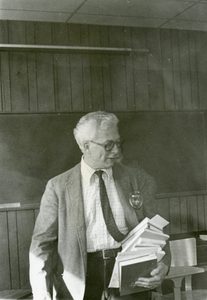 Vern Bailey was a wonder. He combined an abundant 18th century wit (all intelligence and wordplay, with none of today’s cheap sarcasm) with lively delight in the newest technologies. He shaped Carleton, the English Department, and my career, for he embodied interdisciplinary curiosity and expressed it in his scholarly depth and up-to-date knowledge—perhaps most profoundly through film studies, which he introduced into the English Department, transformed into Media Studies with the hiring of John Schott, and fostered into the CAMS department with the hiring of Carol Donelan and an innovative new major at Carleton. When I arrived on campus in 1982, Vern not only encouraged my interest in film and photography, but so insisted on my developing it that he asked me to team-teach his popular course in Film Adaptation (another story, but the class began four days after the birth of my second child, and Vern was so generous and enthusiastic about my contributions that he gave me the course, which over time transformed into Narrative Theory, and led to my recent work in Visual Studies—the Viz Initiative, a Fulbright).
Vern Bailey was a wonder. He combined an abundant 18th century wit (all intelligence and wordplay, with none of today’s cheap sarcasm) with lively delight in the newest technologies. He shaped Carleton, the English Department, and my career, for he embodied interdisciplinary curiosity and expressed it in his scholarly depth and up-to-date knowledge—perhaps most profoundly through film studies, which he introduced into the English Department, transformed into Media Studies with the hiring of John Schott, and fostered into the CAMS department with the hiring of Carol Donelan and an innovative new major at Carleton. When I arrived on campus in 1982, Vern not only encouraged my interest in film and photography, but so insisted on my developing it that he asked me to team-teach his popular course in Film Adaptation (another story, but the class began four days after the birth of my second child, and Vern was so generous and enthusiastic about my contributions that he gave me the course, which over time transformed into Narrative Theory, and led to my recent work in Visual Studies—the Viz Initiative, a Fulbright).
Vern taught me to watch a film four times: once for the overall plot and effect, then for the edits and shots, next the sound, and finally again, to see how it all fit together technically and artistically. When he was most excited by ideas, he would lean back, cross his arms, and speak quietly—he taught me a style of intellectual patience, a love of developing ideas in dialogue, where the fireworks were all in the thoughts and not dramatic delivery. A favorite Vern story: he brought me a VHS tape of Body Double, saying I would love the film’s intelligence. It is, without doubt, the most bloody film I have ever seen—cited (condemned?) in the work of many feminist film theorists—and I stopped the VHS mid-film and stormed into Vern’s office the next morning, reminding him that he knew I hated violence. He looked startled, then laughed, leaned back, and said quietly, “I forgot about that—I was thinking about the theory. I imagine you liked that part.” We went on to consider—years before it became the general topic—the challenge of highlighting without wallowing, of creating critique that does not simply replicate the problem. (We also had great conversations about Madonna as role model, but that also is another story).
Vern celebrated the interdisciplinary intersections that are now common to many fields as signs of open-minded thinking, designed to encourage human thought, and he loved ideas. He joined my children’s kazoo chorus at one department picnic; told my young daughter Ellen about his childhood encounters with bears; let my son Dylan interview him for a middle-school project on soldiers. Before IT or media support existed, Vern encouraged us to enhance our teaching with VHS tapes (and even a flirtation with laserdisc technology), DVDs, and computers. We are all the beneficiaries of his smart, generous spirit, and grateful that he was our colleague.
Susan Jaret McKinstry, Helen F. Lewis Professor of English